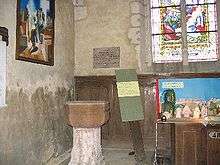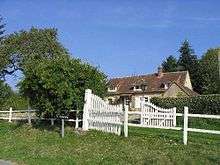Robert Giguère
Robert Giguère dit Despins (March 9, 1616 – August 1709) was an early pioneer in New France, one of the founders of Sainte-Anne-de-Beaupré, Quebec and the progenitor of virtually all the Giguères in North America.
Early life
Unfortunately what is known for sure about Robert Giguère's life in France is very scant. His parents were Jehan (Le Jeune) Giguère (born abt. 1580) and Michelle Jornel. Jehan's brother, Jehan "The elder" married Michelle's sister, Marie. Jehan and Michelle had nine children of which Robert was the sixth. He was baptized in the little church in Tourouvre, in the parish of Saint Aubin on March 9, 1616. Presumably he was born either on that day or just a few days earlier.[1]
It is certain that Robert Giguère was in New France in 1651. However, according to George-Emile Giguère and others, in 1644, he was missing from French census records. Indeed, he could have arrived as early as 1642.[2]
 St. Aubin de Tourouvre |
 Baptismal font at St. Aubin de Tourouvre |
 Close-up of plaque above the baptismal font |
The Perche and Tourouvre

The name "Le Perche" derives from the Latin "Silva pertica" which originally denoted an immense forest on the borders of the Gaulish cities of the Essuins (capital: Sées), the Eburovices (capital: Évreux), the Cenomans (capital: Le Mans) and the Carnutes (capital: Chartres). Located about 100 miles (160 km) southwest of Paris, in Lower Normandy, the Perche has always been a Region. It was created sometime between 1079 and 1100, when Geoffroy IV, one of the region's most powerful landowners, extended his rule over both the county of Corbon (the present area around Mortagne) and the seigneury of Nogent-le-Rotrou, which made him the master of much of the old forest of le Perche. He assumed the title of "Count of le Perche ". His son Rotrou III, who added the seigniory of Bellême to these territories in 1113, brought le Perche to the size of a province, though it remained much smaller than the natural tract of the same name.
When Guillaume, the sixth Count of le Perche, died without an heir in 1226, the county reverted to the Crown. Le Perche would from then on be given out as an estate to the children or brothers of the King of France.
When the departments were being created by the Constituent Assembly in 1792, Le Perche was carved up among four of them: Orne and Eure-et-Loir for the most part, and to a lesser extent, Sarthe and Loir-et-Cher.
As it was in the time of Robert Giguère, the Perche has remained a beautiful pastoral area consisting mainly of gently rolling farmland, but unlike much of France, it is blessed with some beautiful forests. It also benefits from a number of rivers and streams.
Why they came
For several reasons, people left their homes in this seemingly idyllic place to begin anew in a strange place so far away. Leaving everything one has loved and known to make a very long, danger filled journey to an unknown place so far away, could not have been easy in any sense. They were not persecuted or forced to leave, and Le Perche was not a poor area. For the most part, it was unmarried young men who came at least at first, and they came primarily for the adventure of it. That and the fact that the King of France had offered some incentives for his people to settle in New France. One such incentive had to do with the establishment of a group called "La Compagnie des Cent Associes" (The Company of One Hundred Associates) who were to create seigneuries in Quebec, which could then be subdivided and conceded to qualified immigrants. The apothecary and surgeon, Robert Giffard de Moncel in the Perche, was the first to acquire a Quebec seigneury. Granted to him in 1634, his seigneurie was in the area presently called Montmorency County, east of the city of Quebec, with Chateau-Richer and L'Ange-Gardien, as two of the main communities. Giffard, who himself first went to Quebec in 1621, enlisted the aid of the brothers Jean and Noël Juchereau of Tourouvre to recruit people in the area for migration to Quebec. Noel spent much of his time in Perche doing the actual recruiting and contracting of emigrants, while Jean spent most of the time on the receiving end of the migration, in the Province of Quebec. And yet another Juchereau, Pierre, was active in France in readying the emigrants. The emigrants were often hired for a period of three years, thus they were called "Les 36 Mois" (The 36 months). Most of the recruits were bachelors who were to be paid from 40 to 120 livres per year. In addition, they were provided transportation to New France and were to receive some land. Most were unskilled and illiterate.
By the time that Samuel de Champlain died in 1635, there were 132 settlers in the colony—35 of them were from Le Perche. Most of the departures occurred during the period 1634-1662.
The Journey
Something must be said about the courage of the people who made the perilous journey from France to the New World. These poor souls were subject to all sorts of perils: weather, pirates, and illness among the crew and themselves. With so many variables, the length of the trip could vary from one month to over three. For example, it took Jean Talon 117 days to reach Quebec in 1665, but a mere 35 days for the ship, Arc-en-ciel in 1678. From a navigational perspective, it was generally better to set sail from France before May 1.
Ships of the 17th century were generally smaller than 200 tonnes (220 tons), so the accommodations on board were modest. Food would often spoil due to water seepage, and passengers had to settle for cold meals and soggy bedding. Despite all the hardships and perils, most sailors and passengers arrived safely.
The first official mention of Robert Giguère in Canada is on February 21, 1651, when he received a grant of land from Sieur Oliver le Tardif. Located in Beaupre, the grant consisted of 5 arpents (1.7 ha) fronting on the Saint Lawrence River to a depth of 1.5 leagues (7.2 km), and, in addition to the annual rent of 20 sols and 12 deniers per arpent of frontage, it required Robert to establish a residence thereon within a year. If Giguère was in a position to accept such conditions, it may be assumed that he had been already in the country for some years and was familiar with the land, the climate, and was ready to settle down. However, a 1644 census in France found him absent from the country. Although there is no official record of his life in Canada prior to 1651, some historians feel confident that he arrived in New France as early as 1642 (Robert Giguère: Le Tourouvrain 1616–1711(??), 1979).
Marriage
On July 2, 1652, in the Notre-Dame de Québec Cathedral, Robert Giguère married Aymée Miville. He was 36, and she was 17. It was common in those days that men seldom married before the age of 30; women were typically under 20. She was one of the daughters of Pierre Miville dit Le Suisse ("The Swiss"). He was a mercenary soldier who had served in the Swiss Guards of Cardinal Richelieu. The marriage was performed by Father Joseph Poncet, and notably witnessed by Jean de Lauzon, the Governor of New France. This was indeed a great honour and an indication of the respect commanded either by Robert Giguère himself, or by his father in law, Pierre Miville.
In 1660, Jean-Baptiste, their fifth child was born. That same year, both Robert and Aymée were confirmed at Chateau Richer by Msgr. François de Laval who would be named the first bishop of Quebec, in 1674. Some have said that Jean-Baptiste was a scout in the party of men who walked from Montreal to Schenectady, New York and burned the town down in retaliation for the Lacine massacre which occurred in 1689.
Death and legacy
Indications are that Robert Giguère was a well-respected member of the community: he had donated some land for the Basilica in Sainte-Anne-de-Beaupré, Quebec and diligently functioned as head vestryman for some time. He is regarded as a founder of Sainte-Anne-de-Beaupré, Quebec.


No death certificate was recorded for Robert Giguère, or perhaps it was lost. However, most historians agree that he died in August 1709, at the age of 93 years and 5 months. His wife, Aymée Miville followed him in death three years later, on December 10, 1712.
Robert and Aymée had 13 children, seven girls and six boys:
- Marie Charlotte (1653–????)
- Martin (1655–????)
- Jeanne (1657–1673)
- Marie (1659–1710)
- Jean-Baptiste (1660–1750)
- Robert (1663–1711)
- Pierre (1665–????)
- Marie-Anne (1668–1762)
- Etienne (1670–1749)
- Ange (1671–????)
- Joseph (1673–1741)
- Marie-Agnes (1675–1760)
- Marguerite (1678–1723)
Five of his children were married, but only four had children. Of the boys, Joseph, Martin and Jean-Baptiste had children. Joseph and Jean-Baptiste remained in Quebec. Joseph lived out his life in Sainte-Anne-de-Beaupré, Quebec, his descendants would later move across from Quebec City to the beautiful Île d'Orléans. Jean-Baptiste settled in what is now Laprarie, Quebec and his descendants mostly come from Montreal. Martin, ultimately became the ancestor to most all Americans who call themselves Giguère, or any the many variations of the name.
Today there are no direct descendants of Robert Giguère in Tourouvre. One of the few signs that they had been there is a spot known as 'La Giguerie'.
They may have disappeared from Le Perche, but thanks to Robert, thousands of people, including the famous hockey player, Jean-Sébastien Giguère, who call themselves Giguère or one of its many variants, can be found all over North America.
Jean-Baptiste Giguère
Robert Giguère's son, Jean-Baptiste, may have been involved in the burning of Schenectady in 1690. He may have functioned as a scout on the raid. According to, Monseignat, governor Louis de Buade de Frontenac's secretary in his relation of the Schenectady massacre..."A Canadian named Giguère, who had gone with nine Indians to reconnoitre, now returned to say that he had been within sight of Schenectady, and had seen nobody." In his book, "Un Giguère a la guerre avec Iberville" Pierre Le Moyne d'Iberville, Georges-Emile Giguère presents evidence that suggests that the "Giguère" mentioned was Robert's son, Jean-Baptiste. The same Jean-Baptiste may also have been among those who built Fort Detroit.[3]
Spelling variations
There are many variations of the name "Giguère" in use today throughout North America. Among them are:
- Giddière
- Gidier
- Gignier
- Gignière
- Giguair
- Giguaire
- Giguèr
- Giguèrre
- Giguèrres
- Giguert
- Giguet
- Giguery
- Giguir
- Gidière
- Giguiar
- Giguier
- Giguière
- Giguières
- Giguièrres
- Giguère
- Giguir
- Gigyere
- Gegare
- Jigger
Other descendants use the Despins suffix.